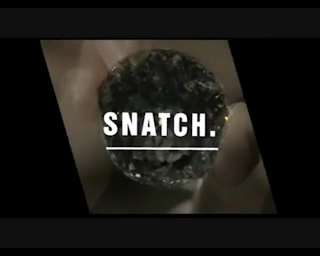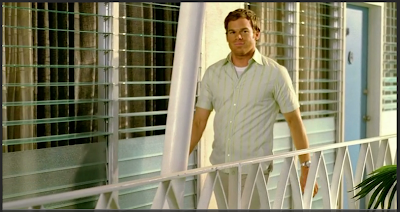We will analyse two films closely related to the crime genre, these films interest us and have useful elements in that we could use in ours. They are both produced by Guy Ritchie.
Snatch
Snatch has a very strong opening, the style of editing coupled with the non diegetic music makes it quite appealing to the viewer, it comes across as light hearted even thought we know that they are about to commit a crime, however the charecters in the movie do not know this, they seem like four normal Jewish men, this creates a feeling of omniscience for the viewer.
This enigma is sustained until they enter the room with the diamonds in, the movie cuts to some close up of the diamonds they plan to steal. (establishing their motive) Once the movie cuts back to the four 'Jewish' men, loud, non diegetic music begins to play whilst the men are arming them selves, this creates drama in the scene, which is then reinforced when the camera zooms in to one of the workers face, which has a look of shock all over it. We see some initial credits as the scene freeze frames on one of the robber's guns. The opening in enticing as it has a strong enigma to it, the viewer wants to keep watching it to find out how the heist goes. The excitement of the opening is also reinforced by the fast pace of the editing, its harder to look away, or to stop watching it.
Once the men have obtained the diamond, they proceed to flea the scene in a van, which once inside, they begin to remove their disguised, this possibly instills a feeling of satisfaction in the viewer, who is now encouraged to continue watching the film. One of the men then begins to examine the diamond, at this point, the movie zooms in to the diamond and the background rotates, perhaps to portray the importance of said diamond to the movie.
The film then has very intricate transitions introducing all the characters in the same fashion.
Revolver
Revolver's opening sequence is quite different from Snatch's instead of going for the action packed, fast paced opening style, is used clever mis-en-scene paired with quiet but tension building non diegetic music to intruige the viewer and make them want to continue watching.
The movie starts with an elipsis of two years on, this suggest prior events will be revealed later on, this in turn creates an enigma to to the movie, the viewer wants to know what happened. Alot of phone calls begin to take place inside the casino, possible in preparation for a big event that is about to happen. A phone call is quiet a clever way to draw in the viewer, as people are naturally nosey and want to know who was on the phone.
The two thugs that surround this powerful figure connote his status and allows everyone to know that he is not to be messed with, this type of charecter is very common on many crime films. Showing these stereotypes in the opening sequence may instil a subconsciously feeling of familiarity in the viewer, they may assume that because of these stereotypes, the film will be good.
The man at the game table... (another stereotype)
Is later shown escorting several men through the casino, this is perhaps to establish his power and position within the casino.
Both of the films have serious crime undertones, and while nothing directly happens in revolver you definitely get the feeling the men in the opening are organised criminals.


















